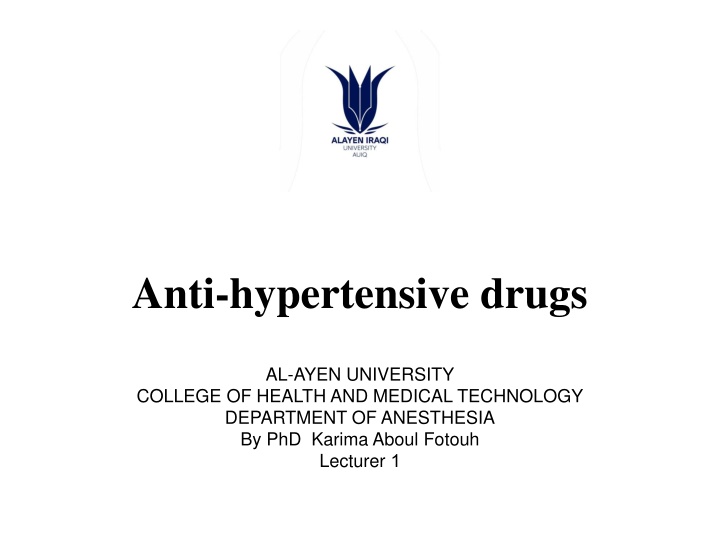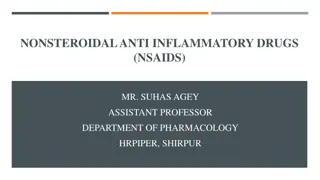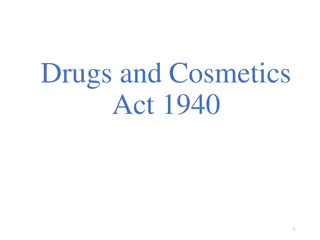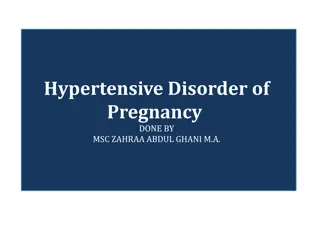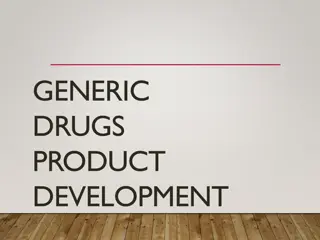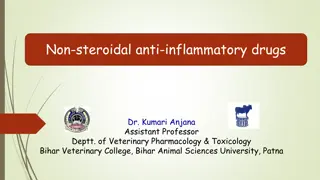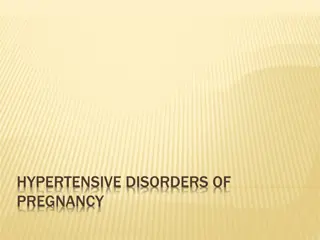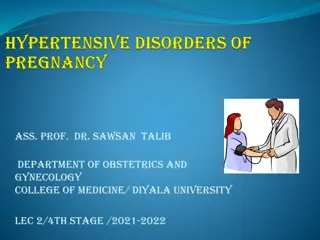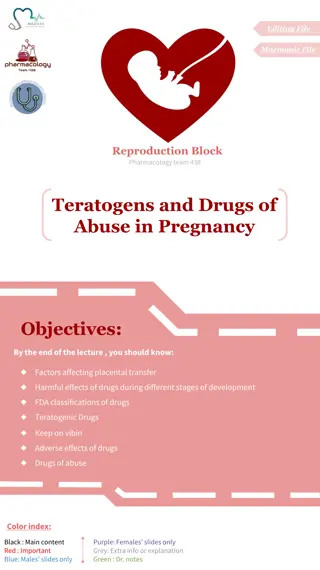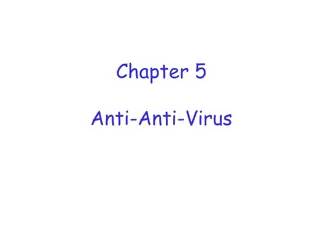Anti-hypertensive drugs
Hypertension, classified into different categories based on blood pressure levels, can result from various factors like genetics, lifestyle, and underlying medical conditions. Treatment options include anti-hypertensive drugs that target different systems to regulate blood pressure effectively. Renin-angiotensin-aldosterone system and sympathetic nervous system play crucial roles in blood pressure control. This comprehensive guide explores the mechanisms, classifications, and factors associated with hypertension and highlights the importance of managing blood pressure for overall health.
Download Presentation

Please find below an Image/Link to download the presentation.
The content on the website is provided AS IS for your information and personal use only. It may not be sold, licensed, or shared on other websites without obtaining consent from the author.If you encounter any issues during the download, it is possible that the publisher has removed the file from their server.
You are allowed to download the files provided on this website for personal or commercial use, subject to the condition that they are used lawfully. All files are the property of their respective owners.
The content on the website is provided AS IS for your information and personal use only. It may not be sold, licensed, or shared on other websites without obtaining consent from the author.
E N D
Presentation Transcript
Anti-hypertensive drugs AL-AYEN UNIVERSITY COLLEGE OF HEALTH AND MEDICAL TECHNOLOGY DEPARTMENT OF ANESTHESIA By PhD Karima Aboul Fotouh Lecturer 1
Hypertension defined as persistently elevated arterial blood pressure o A systolic blood pressure (SBP) > 140 mmHg and/or o A diastolic blood pressure (DBP) > 90 mmHg CLASSIFICATION BP is classified according to the JNC report into 4 categories SBP Normal BP Prehypertension 120 - 139 Stage-1 HTN 140 - 159 Stage-2 HTN DBP < 80 80-89 90-99 > 100 < 120 > 160
Factors implicated in primary hypertension include: Age Genetics and family history Environment Sodium intake Weight Alcohol intake Race
Secondary Hypertension Causes Renal disease Drug Induced NSAIDs Oral contraceptive Corticosteroids Pregnancy Endocrine Conn s Syndrome Cushing s disease Phaeochromocytoma Hypo and hyperthyroidism
Control of blood pressure Blood pressure is controlled by an integrated system Prime contributors to blood pressure are: Cardiac output Peripheral vascular resistance Kidneys and blood vessels strive to regulate and maintain a normal BP.
Sympathetic Nervous System Sympathetic system activation produces Vasoconstriction Tachycardia Increased cardiac output In this way blood pressure is increased
The renin-angiotensin-aldosterone system The RAAS is pivotal in long-term BP control The RAAS is responsible for: Maintenance of sodium balance Control of blood volume Control of blood pressure
Angiotensinogen Kininogen Renin Angiotensin I(inactive) Bradykinin PGs ACE === Kininase II V.D. Angiotensin II, III inactive V.C. TPR aldosterone Na+ retention, hypokalemia sympathetic transmission& catecholamine release. Hypertrophy of cardiovascular system and remodeling.
Both the sympathetic and RAAS are key targets in the treatment of hypertension
Management of Hypertension 1.Life-style modifications (non drug therapy) Required for normotensive, pre- hypertensive and hypertensive patients 1) Weight reduction ( 10 kg weight 5-20 mmHg). 2) Salt restriction (< 6 g / day 2-8 mmHg). 3) Cessation of smoking 4) Regular mild exercise (e.g. walking 4-9 mmHg). 5) Avoidance of saturated fats 6) Potassium-rich foods 7) Avoidance of stressors (e.g. noise & excessive light)
DRUG THERAPY Diuretics. Calcium channel blockers. Sympatholytic K channel opener Direct vasodilators. Angiotensin converting enzyme inhibitors (ACEIS) Angiotensin receptor antagonists (ARBs)
Goal Blood Pressure (jNC 8) 1) Achieving a BP < 140/90 mmHg in most patients including those with diabetes or chronic renal disease. 2) Achieving a BP < 150/90 mmHg in patients > 60 years. Stage I Hypertension (SBP 140-159 and /or DBP 90-99 mmHg) treated as Start with single agent Thiazide diuretics for most ACEI, ARB, BB, or CCB (alternatives) Optimize dosage or add other drugs to achieve goal BP (after a trial of 1 month). Stage II Hypertension (BP 160/100 mmHg) Two-drug combination for most (usually a thiazide type diuretic plus ACEI, ARB, BB or CCB). Optimize dosage or add other drugs to achieve goal BP (after a trial of 1 month).
1. diuretics They include : Thiazide and thiazide like as chlorothiazide, hydrochlorothiazide, chlorothalidone. Loop diuretice as furosemide, ethacrynic acid and bumetanide . Mechanism of action : Direct action reducing peripheral resistance Decreased blood volume and COP . Decreased sodium in vessel wall so reduce its sensitivity to noradrenaline and adrenaline .
Adverse effects: The most common adverse effect (except for potassium-sparing diuretics) is potassium depletion
Potassium sparing diuretics as spironolactone, triamterene and amiloride . Theyare useful to avoid hypokalemia induced by other diuretics and to enhance the effect of other diuretics, and useful in patients used digitalis .
Sympatholytic agents Adrenoceptor blockers and - blockers. Adrenergic neuron blockers which inhibit noradrenaline release (guanethidine, bretylium) or deplete noradrenaline stores ( reserpine). Inhibitors of noradrenaline synthesis ( - methyl dopa, - methyl tyrosine). Ganglion blockers. 2stimulants (clonidine, guanfacine, guanabenz and - methyl dopa).
Sympatholytic agents A ) Centrally acting : ( inhibit V.M.C. = 2 agonists ) Methyl dopa, clonidine, guanfacine, guanabenz 2 stimulants reduce sympathetic outflow from vasopressor centers and their hypotensive effect is less dependent on posture . They also decrease renal vascular resistance so used in hypertension with renal insufficiency .
(1) -methyl dopa (Aldomet) Mechanism of action: Central mechanism: through stimulation of 2receptors sympathetic out flow HR , COP, TPR BP presynaptic 2receptors NA Renin release Inhibits L amino acid decarboxylase enzyme, so inhibits of catecholamines and serotonin synthesis.
Uses : Hypertension especially if accompanied by renal impairment and in pregnancy . Minimal or postural hypotension occurs .
(2) Clonidine It act directly on 2 receptors so inhibit sympathetic outflow from C.N.S., and inhibit noradrenaline release . It is used in treatment of hypertension especially with renal impairment (it does not decrease renal blood flow) .
B ) Ganglion blocking agents : Trimethaphan, which is given by I.V drip . Adverse effects: sympathoplegia (excessive hypotension and sexual dysfunction) and parasympathoplegia (constipation, blurred vision,dry mouth, ) C ) Adrenergic neuron blockers : ( 1 ) Guanethidine It inhibits the release of noradrenaline from sympathetic nerve ending, it depletes catecholamine stores . It is strong antihypertensive, rarely used.
( 2 ) Reserpine Alkaloid of rauwolfia serpentina root ( plant origin ), given orally and passes to brain . Mechanism of action : It depletes catecholamines(NE and dopamine) and serotonin ( 5HT ) central and peripheral . It blocks the ability of vesicles to store these biogenic amines by interfering with vesicular uptake Action : sympathetic and parasympathetic . C.N.S. : Sedation . C.V.S. : Hypotension and bradycardia . Uses: Mild and moderate hypertension, Antipsychotic ( rarely used ) .
. -Arenoceptor Blockers Pharmacokinetics:They are given orally or IV and sustained release preparations are available(e.g. propranolol) Lipophilic: as propranolol, timolol, metoprolol. Hydrophilic: as nadolol, atenolol, sotalol. Nadolol, atenolol and sotalol are less lipid soluble so have poor CNS actions. They have long duration so given once daily.
Non selective blockers ( Propranolol) Prototype Pharmacological action of propranolol 1)Heart ( 1 receptor activation) COP a) Contractility (- ve Inotropic effect). b) Heart rate(- ve Chronotropic effect). c) Conductivity The resulting bradycardia usually limits the dose of the drug (- ve Dromotropic effect). 2) Blood vessels Peripheral vasoconstriction: Blockade of receptors prevents 2 mediated vasodilation VC blood flow to the periphery coldness of extremities ( 1 effect). oHowever in long term therapy peripheral resistance. No postural hypotension occurs, N.B Because receptors that control vascular resistance are unaffected.
3) Bronchoconstriction Blocking 2 receptors in the lungs of susceptible patients contraction of the bronchi contraindicated in patients with a)Chronic obstructive pulmonary disease (COPD) b)Asthma. 4) Disturbances in glucose metabolism: glycogenolysis and glucagon secretion. 5) Blocked action of isoproterenol on CVS & vasoconstriction effect of E.
Therapeutic effects 1)Hypertension ( Propranolol blood pressure by) a)Cardiac output why ???? b)Inhibition of renin release from the kidney. c) Sympathetic out flow from the CNS. (block presynaptic receptors) d)Resetting of baroreceptor mechanism 2) Migraine Preventing migraine attack when used prophylactically. 3) Hyperthyroidism Effective in suppressing the widespread sympathetic stimulation that occurs in hyperthyroidism. 4) Angina pectoris Useful in the chronic management of stable angina. It decreases the oxygen requirement of heart muscle. 5) Myocardial infarction: Protective effect on the myocardium. Patients who have had one myocardial infarction appear to be protected against a second heart attack by prophylactic use of blockers.
. Timolol & Nadolol Nadolol has a very long duration of action (14 24 h). Timolol is used for 1)Hypertension, 2)congestive heart failure 3)acute MI 4)migraine prophylaxis 5)Topically in eyes for treatment of chronic glaucoma ( aqueous humor production)
Cardio Selective Cardio Selective 1 1 antagonists antagonists More selective, less side effects than non selective blocker so may be used in the following patient 1) Asthmatic patients 2) Diabetic patients 3) Peripheral vascular disease patients
Potassium channel openers (PCO's) Potassium channel openers (PCO's) Minoxidil,Diazoxide , Cromakalim , Lemakalim , Bimakalim K channel opening is a new drug principle in cardiovascular medicine o Possibilities in acute coronary syndrome, cardioprotection, heart failure & hypertension Mechanism of action Open potassium channels the membrane which reduces ca+ion entry & contraction K efflux hyperpolarization of Therapeutic uses 1)Hypertension 2)Coronary artery disease 3)Potent arterial vasodilator Side effect Headache, flushing, edema & dizziness (as potent vasodilators)
3. Direct Vasodilators Classifed into : A. Arteriolar: Hydralazine, minoxidil ( oral ), diazoxide ( I.V. ). B.venodilator nitroglycerin C. Balanced (non selective) dilators : Sodium nitroprusside ( I.V.drip ).
Vasodilators Decreased TPR Decreased Na+Decreased B.P Increased symp. Tone excretion Increased renin IncreasedIncreasedIncreased contraction aldosterone angiotensin II Increased H.R. Increased TPR Na+ retention Increased B.P. Increased C.O.
1 Hydralazine : Mechanism of action: Direct vasodilator of arterioles. it may act by opening of K+ channels with hyperpolarization of vascular membrane. Uses : Hypertension especially with renal insufficiency Heart failure . It is oral or I.V. in emergencies . Adverse effects : Tachycardia, palpitation, arrhythmia, anginal pains ( sympathetic).
Contraindications : Angina pectoris and arrhythmia. 2)Minoxidil : Mechanism of action: Very effective potent oral vasodilator affecting arteioles, it may act by opening of K+ channels . It is prodrug . Uses : Hypertension ( severe, with renal impairment and in patients needing high dose of hydralazine ) . It should be combined with loop diuretic and beta-blocker . Heart failure . Topical in alopecia or baldness . Adverse effects : Tachycardia abnormal hair growth (hypertrichosis) . Contraindication : in angina pectoris and in arrhythmias. .
3)Diazoxide : Mechanism of action: It may act by opening of K+ channels . hyperglycemia, Uses : Emergency hypertension given I.V. Treatment of hypoglycemia due to hyperinsulinism ( cell tumor) Adverse effect : 1. Severe hypotension . 2. Angina pectoris. 3. Hyperglycemia,
4)Sodium nitroprusside ( Nipride ) : Mechanism of action: Powerful parenteral short acting vasodilator, it dilate arterial and venous vessels, it decreases preload and afterload Uses : Hypertensive emergencies . In acute heart failure . Adverse effects : Excessive hypotension, arrhythmia
4. Ca+2 channel blockers Verapamil, diltiazem, nifedipine, nicardipine, amlodipine. They lower B.P. by relaxing arteriolar smooth muscles and decrease TPR Unlike arteriolar dilators they do not cause fluid retention . Mechanism of action: Block the voltage sensitive calcium channel They are usually safe in hypertensive patients with asthma, hyperlipidemia,. Nicardipine is given I.V. for emergency hypertension .
Uses: Antihypertensive. Antianginal (all types) Anti-arrhythmic (Verapamil and diltiazem ) . Bradycardia and heart block with (Verapamil and diltiazem ) . Reflex tachycardia with (nifedipine, nitrendipine).
5. Drugs affecting renin angiotensin Angiotensinogen Kininogen Renin Kallikrein Angiotensin I(inactive) Bradykinin PGs ACE === Kininase II V.D. Angiotensin II, III inactive V.C. TPR BP PR aldosterone Na+ retention BP ,hypokalemia BP sympathetic transmission& catecholamine release. Hypertrophy of cardiovascular system and remodeling.
A )Angiotensin converting enzyme inhibitors ( ACE inhibitors ) : ACE inhibitors include : Captopril, Lisinopril . Pro-drugs : Enalapril, fosinopril, benazepril, ramipril, prindopril . Pharmcokinetics: Given orally. I.V . Enalaprilat is available in emergency hypertension . Mechanism of actions : They inhibit ACE, kininase II and may inhibit other enzymes so decrease angiotensin II and increase bradykinin VD . They decrease TPR, aldosterone salt and water retention. sympathetic transmission and reduce both pre-and afterload and B.P. without postural hypotension . *COP and H.R. are not significantly changed but renal flow is increased .
Uses : 1. Hypertension , 2. Heart failure. 3. Myocardial infarction, 4. Diabetic nephropathy
Adverse Effects : Dry cough, angioedema, due to bradykinin .
B ) Angiotensin receptor antagonists : Losartan, candesartan, telmisartan and valsartan Theyare angiotensin receptor antagonists selective for AT1 receptors so block the pressor response, stimulatory effect on sympathetic system, release of catecholamines, secretion of aldosterone and growth promoting action . Uses:They are used in hypertension (as ACE inhibitors ) and under trials for heart failure .
Management of hypertensive emergencies Parentel antihpertensive drugs is used in hypertensive emergencies: Sodium nitroprusside, trimethaphan, diazoxide, labetalol, hydralazine enlaprilat, nicardipine are effective . Esmolol is used to manage intra and postoperative hypertension.
Drugs used for treatment hypertension in pregnancy: First line agent: Methyldopa Second line agents: Nifedipine Drugs used for treatment hypertension in diabetic patient: angiotensin-converting enzyme (ACE) inhibitors, angiotensin receptor blockers (ARBs). Drugs used for treatment hypertension in renal failure: angiotensin-converting enzyme (ACE) inhibitors, angiotensin receptor blockers (ARBs). Loop and thiazide diuretics. Drugs used for treatment hypertension in asthma and hyperlipidemia: Ca+2 channel blockers , amlodipine.
Drugs used for treatment hypertension with heart failure: angiotensin converting enzyme (ACE) inhibitors, angiotensin receptor blockers, beta blockers. Drugs used for treatment hypertension with angina pectoris: Calcium channel blocker or -blockers.
